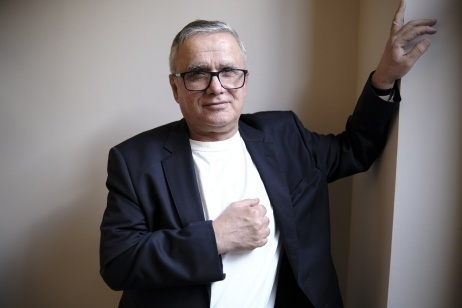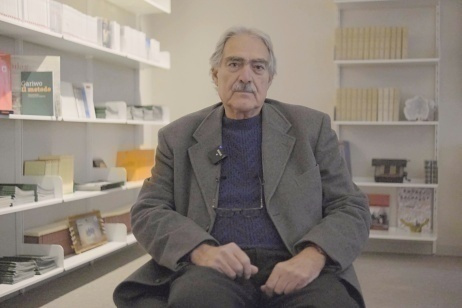"Our task is to keep the memory alive and prevent something similar from happening again," Robert tells me at the end of our conversation. Robert Waltl is an actor, a theater director, and a puppeteer. His artistic world is the Mini Teater, a company he founded, now one of the best-known in Slovenia, specialized in creating and staging performances for both young and old audiences. I met Robert right there, in front of the door of his Mini Teater, in the beautiful city of Ljubljana, on the charming Križevniška ulica.
In Križevniška ulica, one of the most picturesque streets in the Slovenian capital, you walk on its cobblestones, surrounded by plants that burst with green life in the summer. Then, you stop to read names and stories painted on some benches. Names like Zora Pičulin, who hid a two-year-old Jewish child she was caring for and saved him from being deported to Treblinka along with his parents. Or France Punčuh, a diplomat who sheltered and supported several Jewish families in Warsaw. There's also Uroš Žun, a lawyer who saved 16 Jewish girls who had escaped from Austria, and Andrej Tumpej, a priest who saved a Jewish mother and daughter before being executed by the Gestapo. These are just a few of the stories of the Righteous Among the Slovenians that the Judovski Kulturni Center (Jewish Cultural Center) of Ljubljana has chosen to honor and remember with this artistic installation. The JKC represents the liberal Jewish community in Ljubljana, and Robert is its director.
Robert is busy with rehearsals for a play and finalizing the details for the opening of the first permanent Holocaust exhibition in Slovenia at the newly established museum of the community. It's housed within the beautiful and ancient building on Križevniška ulica, which also hosts a small synagogue. Robert divides his time between a group of actors chatting in front of a café and curious visitors who have just toured the museum with him. I asked for information about the center's activities and the museum, and Robert kindly offered to give me an informal tour. "We still need a few small adjustments, but we're almost there. If you'd like, I can still show you around." I can only accept and climb the steep stairs to the upper floor.
What I see in front of me is different from many others I've visited on the subject. Here, the public dimension of history is taken seriously. In addition to informative panels that are easily accessible even for those new to the topic, the museum is enriched with screens where actors portray some of the Righteous whom we discussed earlier, and there are artistic installations where, starting from their names, the faces of those who were deported without leaving behind any photos are recreated. Everything here speaks about people—men, women, the elderly, children—remembered in the present, not lost in the past. I had just discovered an unexpected gem nestled in a city that continued to surprise me. I don't let go of Robert and eagerly start to ask him questions. I want to know about the Slovenian Jews of yesterday and today, the performances they stage, their activities with schools, and the role of such an entity in contemporary Slovenian society. Robert is very kind and takes the time to answer all my questions.
What is the Judovski Kulturni Center, how did it come into being, and how does it function?
The JKC was founded in 2013 and immediately became a special place, deeply rooted in historical heritage and dedicated to preserving Jewish culture and promoting tolerance and solidarity. This mission is carried out in close collaboration with the Mini Teater, through events and festivals that usually coincide with Jewish cultural holidays and aim to make the presence of Jews in Slovenia known, along with their history, the remarkable people who have enriched it, and the terrible fate they have endured during the Holocaust. But we don't limit ourselves to organizing cultural events or seminars; we also strive to promote cultural cooperation among Jews in Slovenia, the diaspora, and Israel.
We believe that culture is a powerful way to promote tolerance and better understanding, discover new perspectives, and foster personal and communal growth. We are particularly committed to Holocaust education, seeking to teach and make people understand the various facets of this historical period and its impact on society. We are delighted to see more and more people participating in our events, and visiting the Museum and the Synagogue, which attract many tourists during the summer. For us, culture and art are a duty.
So, let's start with the Ljubljana Jewish community. Who were these people? What did they do, and what role did they play in Slovenian society?
Before the Second World War, Ljubljana and Slovenia had a small but vibrant Jewish community, consisting of around 200 people. In Ljubljana, they lived in various parts of the city, including Križevniška ulica, and constituted an important part of the local societal fabric. Among others, there were the Pollak, Ebenspanger, Bolaffio, Silberstein, Steinberg, Baumgarten, Moskovič, Kapper, Lorant, Goldstein, and Obla families.
These individuals were professionals from various fields, including doctors, merchants, shoemakers, bankers, builders, lawyers, and students. They were united, deeply attached to their customs and traditions, but not exclusive; the spirit of openness and coexistence with other faiths in Slovenian society was always strong. In addition to actively participating in the city's cultural and economic life, members of the Jewish community often entered into interfaith marriages.
We explored the pre-war lives of the Ljubljana Jews in a performance we called "Jewish Life in Ljubljana," a project carried out by Slovenian and Israeli artists. The script was written by me (Robert Waltl) and Vinko Möderndorfer, directed by Israeli Yonatan Estrkin, and the actors came from both Mini Teater (Tadej Pišek, Timotej Novaković, Barbara Vidovič, and Nika Korenjak) and the Yiddishpiel Theater in Tel Aviv (Nathan Hecht, Omer Rozenblum, and Hanna Hill).
And then? What happened to this community in April 1941?
Then comes the most painful and tragic chapter in their history. In April 1941, with the Axis powers' offensive against Yugoslavia, the Italians arrived in Ljubljana. Less than a month later, the so-called Province of Ljubljana was annexed to the Kingdom of Italy. At that point, a highly complex and challenging period began for Slovenian Jews, with dramatic situations for everyone: some managed to escape to Switzerland, some were sent to camps (especially Ferramonti di Tarsia near Cosenza), some were killed in reprisals, some were expelled, and some joined the partisans.
In February 1942, the situation worsened further when the occupiers surrounded the city with barbed wire, finally restricting the freedom of movement of its residents. Then came September 1943, the surrender of the Italians, and the territory coming under German control. The level of violence and persecution of Jews and partisans escalated at that point, aided by the formation of the feared Slovenian Territorial Guard, composed of local collaborators to counter the People's Liberation Army of Yugoslavia.
The situation reached its peak of gravity in October 1943, with an order issued by Gauleiter Friedrich Rainer for the confiscation of all Jewish property in the territory of the Adriatic Littoral Operational Zone (as the Germans called the provinces of Udine, Gorizia, Trieste, Pola, Rijeka, and Ljubljana). At that point, the German occupiers began an unrelenting hunt for Jews who were still on the territory and deported them to Dachau, Auschwitz, Ravensbrück, or Mauthausen.
The victims, but also the saviors. Can you tell us more about the benches that display the faces and stories of the Slovenian Righteous?
That's an exhibition inaugurated in June and will remain in Križevniška ulica until Hanukkah, on December 15. We called it "The Slovenian Schindlers," and it presents the stories of the Slovenian Righteous, men or women who, during the darkest times for Jews, decided not to look the other way but act to save lives or at least make them a bit easier.
We believe that the issue of human responsibility towards others is of utmost importance in our time, particularly understanding the consequences of our actions on ourselves and others. Being responsible makes us more human. Jewish tradition teaches us that when a human being is in danger, we must intervene to save them. This is a "mitzvah," a good and just act. An ancient Talmudic teaching tells us that saving one life is like saving the entire world.
The Righteous Among the Nations we decided to represent in our benches are Uroš Žun, Andrej Tumpej, Zora Pičulin, Ivan Breskvar, Ivan e Ljubica Župančič, Vera e Ludvik Valentinčič, Martina Levec Marković, Rudimir Rudolf Roter, France Pančuh, Aleksander e Agnes Žilavec, Jožef Fratelj, Marija e Franc Fratelj e la famiglia Rožanc, composta da Savica, Mihael ed Ema. They are those who place responsibility for others above their own fear and life. The whole world should know about their heroism.
Who do you want to tell the story of the Ljubljana Jewish community? Who is your audience?
Everyone. Slovenians, residents of Ljubljana, tourists. Adults, teenagers, children. Our activities are based on the belief that the Holocaust is not and cannot be considered a story of the distant past but should be an integral part of the education of Slovenian citizens and a reminder in the consciousness of everyone. We have noticed that not enough is being done in this direction in Slovenia; for example, in Slovenian museums (from the Museum of Contemporary History to the National Museum of Ljubljana, as well as the numerous smaller museums across the country), the history of Slovenian Jews is not included in the national Slovenian history. What you will find mostly relates to their expulsion in 1496 and 1515, which is a significant underrepresentation of everything we've just talked about.
The situation is equally drastic for young people who are not familiar with the history of Slovenian Jews and the Holocaust. With the House of Tolerance festival, created in collaboration with my dear friend Branko Lustig (a Holocaust survivor who, as a child, survived Bergen-Belsen and went on to become an Oscar-winning film producer for "Schindler's List" and "Gladiator"), we organize educational mornings where young people watch films, theater performances, and book presentations, followed by Holocaust survivors and members of the Jewish community.
One of our performances that we have presented several times during these mornings, involving thousands of boys and girls, is "The Diary of Anne Frank." As Vinko Möderndorfer, who wrote and directed the play, says, Anne's diary is a vivisection of human relationships in specific circumstances, but also a vivisection of growth, the birth of love. It is the story of Romeo and Juliet during the Holocaust and the European apocalypse. It's the story of how love wants to conquer death. But it's also a story of disillusionment. It's a story of fear. A story of a future stolen from millions of people. In some part of her diary, Anne says, "It hurts me to think that all the people who were once so close to me, my school friends, are now at the mercy of the worst scoundrels that ever existed. Why? Are we different? Are we really different? Because we are all human. People who feel pain, fear, love... I don't understand, I really don't understand. What happened to people?". With our work, we aim to make people understand that the questions we must ask today are the same ones Anne was asking so that what happened will never be repeated. Anne's story is our story.







